With the continuous improvement of the quality requirements for machined products, people have invested a lot of time and energy in exploring methods and measures to improve product quality, but they have ignored the impact of machining allowance on product quality in the process of machining, and believe that only having allowance in the process will not have much impact on product quality. In the actual machining process of mechanical products, it is found that the machining allowance of parts directly affects the product quality.
If the machining allowance is too small, it is difficult to eliminate the residual form and position errors and surface defects in the previous process; If the allowance is too large, it will not only increase the workload of machining, but also increase the consumption of materials, tools and energy. What is more serious is that the heat generated by cutting a large amount of machining allowance during the machining process will deform the parts, increase the machining difficulty of the parts and affect the product quality. Therefore, it is necessary to strictly control the machining allowance of the parts.
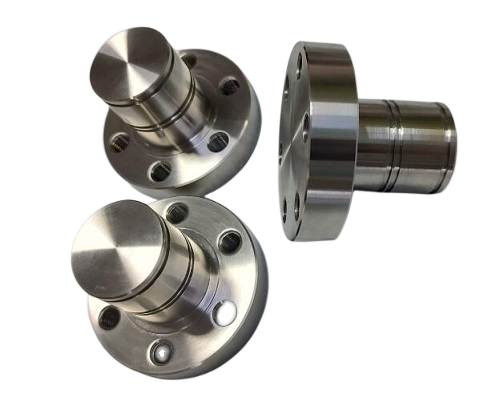
1. Concept of Machining Allowance
Machining allowance refers to the thickness of the metal layer cut from the machined surface during machining. Machining allowance can be divided into process machining allowance and total machining allowance. Process machining allowance refers to the thickness of the metal layer removed from a surface in one process, which depends on the difference between the dimensions of the adjacent processes before and after the process. Total machining allowance refers to the total thickness of the metal layer removed from a certain surface during the whole machining process of the part from blank to finished product, that is, the difference between the blank size on the same surface and the part size. The total machining allowance is equal to the sum of machining allowance of each process.
Because there are inevitable errors in the blank manufacturing and the dimensions of each process, both the total machining allowance and the process machining allowance are variable values, resulting in the minimum machining allowance and the maximum machining allowance. Machining allowance and tolerance are shown in Figure 1. In the figure, the minimum machining allowance is the difference between the minimum process size of the previous process and the maximum process size of the current process; The maximum machining allowance refers to the difference between the maximum process size of the previous process and the minimum process size of the current process. The variation range of the process machining allowance (the difference between the maximum machining quantity and the minimum machining allowance) is equal to the sum of the dimensional tolerances of the previous process and the current process. The tolerance zone of process dimension is generally specified in the entry direction of parts. For shaft parts, the basic dimension is the maximum process dimension, while for holes, it is the minimum process dimension.
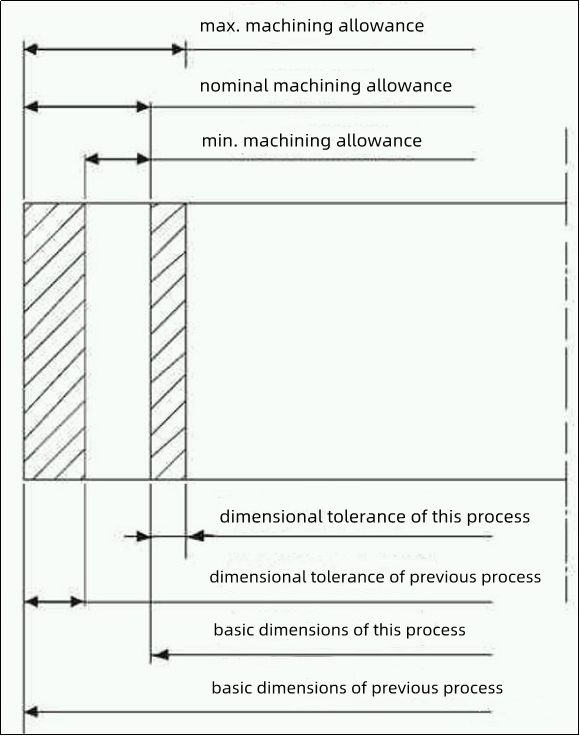
2 Analysis of the influence of machining allowance on machining accuracy
2.1 influence of excessive machining allowance on machining accuracy
Parts must generate cutting heat in the machining process. Some of these cutting heat are taken away by iron filings and cutting fluid, some are transferred to the tool, and some are transferred to the workpiece to raise the temperature of the parts. The temperature is closely related to the machining allowance. If the machining allowance is large, the rough machining time will inevitably become longer, and the cutting amount will also be appropriately increased, resulting in the continuous increase of cutting heat and part temperature. The greatest harm brought about by the temperature rise of parts is the deformation of parts, especially for materials sensitive to temperature change (such as stainless steel). Moreover, this kind of thermal deformation runs through the whole processing process, increasing the processing difficulty and affecting the product quality.
For example, when machining slender shaft parts such as screw rods, the degree of freedom in the length direction is limited due to the one-on-one machining method. At this time, if the workpiece temperature is too high, thermal expansion will occur. When the extension of the length direction is blocked, the workpiece will inevitably produce bending deformation under the influence of stress, which will bring great trouble to the later processing. The bending deformation diagram of the workpiece after heating is shown in Figure 2. At this time, if the processing continues, the protruding part will be processed until the finished product. After cooling to normal temperature, the parts will produce reverse deformation under the action of stress, resulting in form and position errors and affecting the quality. The bending deformation diagram of the workpiece after normal temperature is shown in Figure 3. After expanding in the diameter direction, the increased part will be cut off, and cylindricity and dimensional error will occur after the workpiece is cooled. When grinding precision screw, the thermal deformation of workpiece will also cause pitch error.
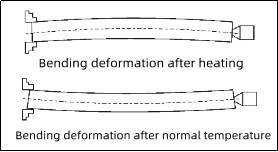
2.2 influence of too small machining allowance on machining accuracy
The machining allowance of parts shall not be too large or too small. If the machining allowance is too small, the residual geometric tolerance and surface defects in the previous process cannot be eliminated, thus affecting the product quality. In order to ensure the machining quality of parts, the minimum machining allowance left in each process shall meet the basic requirements of the previous process. The schematic diagram of the components of the minimum machining allowance for the inner hole of a part is shown in Figure 4. Figure 4a) shows the parts of the inner hole to be machined. If the axis o1-o1 deviates from the reference axis O-O with position error n during the previous process, and the inner hole has cylindricity error P (such as taper, ellipse, etc.) and surface roughness error H (as shown in Figure 4b), in order to eliminate the geometric tolerance before boring, the minimum machining allowance on one side of the boring process shall include the values of the above errors and defects. Considering that the workpiece inevitably has installation error during boring in this process, that is, the error E (as shown in Figure 4C) between the original hole axis O-O and the rotation axis O ′ -o ′ after workpiece installation, and the dimensional tolerance T during boring in this process, the minimum machining allowance Z of this process can be expressed by the following formula:
Z ≥ t/2+h+p+n+e (single side allowance)
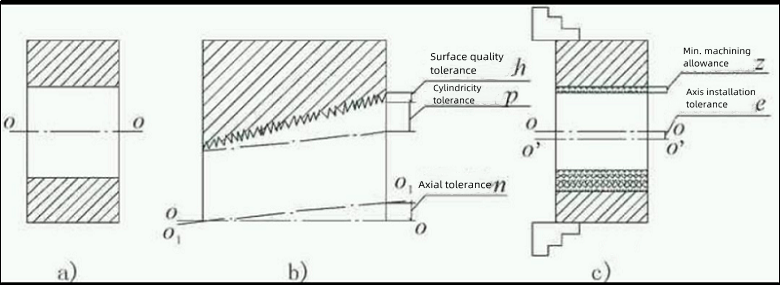
Diagram of components of minimum machining allowance
For different parts and different processes, the values and forms of the above errors are also different. It shall be treated differently when determining the process machining allowance. For example, the slender shaft is easy to bend and deform, and the linear error of the busbar has exceeded the tolerance range of the diameter dimension, so the process machining allowance should be appropriately enlarged; For the process of machining with floating reamer and other tools to locate the machining surface itself, the influence of installation error E can be ignored, and the process machining allowance can be reduced accordingly; For some finishing processes mainly used to reduce surface roughness, the size of process machining allowance is only related to surface roughness H.
3. Reasonable selection of machining allowance
3.1 principles for machining allowance of parts
The selection of machining allowance is closely related to the material, size, accuracy grade and machining method used by the part, which shall be determined according to the specific situation. The following principles must be followed when determining the machining allowance of parts:
(1) The minimum machining allowance shall be used to shorten the machining time and reduce the machining cost of parts.
(2) Sufficient machining allowance shall be reserved, especially for the final process. The machining allowance shall ensure the accuracy and surface roughness specified on the drawing.
(3) When determining the machining allowance, the deformation caused by heat treatment of parts shall be taken into account, otherwise waste products may be generated.
(4) When determining the machining allowance, the machining method and equipment as well as the possible deformation during machining shall be considered.
(5) The size of machined parts shall be considered when determining machining allowance. The larger the part, the larger the machining allowance. As the size of the part increases, the possibility of deformation caused by cutting force and internal stress will also increase.
3.2 method for determining machining allowance
3.2.1 empirical estimation method
Experience estimation method is commonly used in production practice. It is a method to determine machining allowance based on the design experience of process personnel or comparison with similar parts. For example, the machining allowance of rudder stock, rudder pin, intermediate shaft and stern shaft of ships under construction is determined according to the design experience of technicians for many years. In consideration of the importance of the workpiece and the influence of factors such as large volume and large forging blank stress, 6 mm semi fine turning allowance is reserved after rough turning, 3 mm fine turning allowance is reserved after semi fine turning, and 1 mm grinding allowance is reserved for fine turning. In order to prevent the production of scrap due to insufficient machining allowance, the machining allowance estimated by empirical estimation method is generally too large. This method is often used in single piece and small batch production.
3.2.2 table lookup correction method
The look-up table correction method is a method to determine the machining allowance based on the data related to machining allowance accumulated in production practice and experimental research and revised in combination with the actual machining conditions. This method is widely used. See Table 1 and table 2 for machining allowances of bearing parts after rough turning and fine turning and grinding.
3.2.3 analysis and calculation method
Analysis and calculation method is a method to determine machining allowance by analyzing and comprehensively calculating various factors affecting machining allowance according to test data and calculation formula. The machining allowance determined by this method is accurate, economical and reasonable, but it needs to accumulate comprehensive data. It is not as simple and intuitive as the above two methods, so this method is rarely used at present.
4 Conclusion
In the actual production, the manufacturing methods of many parts are temporarily determined, such as: the stainless steel sleeve cast by centrifugal casting is welded after being rolled by steel plate; The cooler end cover, motor base and gear box sanding parts shall be replaced with welding parts. There are many uncertain factors in the manufacturing process of these parts, and its shape error is difficult to predict. Therefore, the three methods to determine the machining allowance introduced in this paper are not applicable to the determination of machining allowance of such parts, and can only be flexibly mastered in the actual manufacturing process.
Table 1 machining allowance of shaft parts after rough turning and fine turning outer circle mm
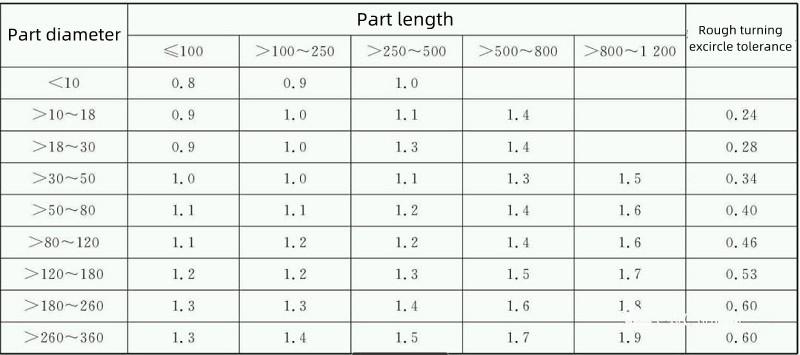
Table 2 machining allowance for grinding excircle of shaft parts mm
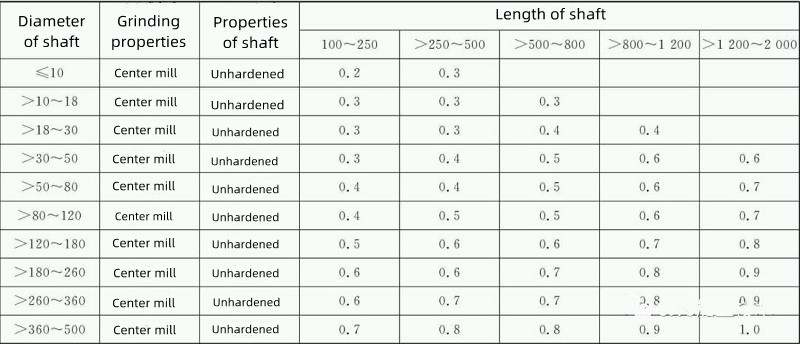
Dongguan Yejia Precision Machinery Co., Ltd. has CNC large-scale gantry machining centers, CNC machining centers, precision CNC milling machines, lathes, large surface grinders, precision shape correction machines, CMM three-coordinate measuring machines, electronic altimeter and other advanced manufacturing and testing equipment more than 90 sets.The maximum size that can be processed is 5000×3200×1000mm, and the machining accuracy can reach 0.002.
Welcome to contact Janice for more information: sales2@yejiavi.com / +86-13326893009 .








